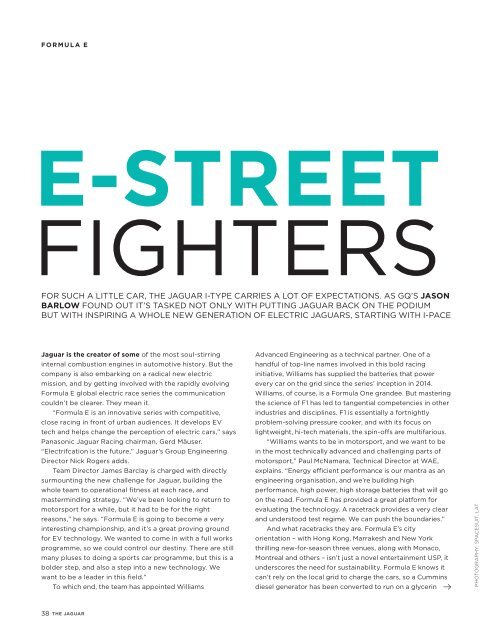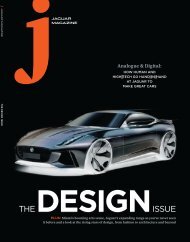JM_0216_UK
Create successful ePaper yourself
Turn your PDF publications into a flip-book with our unique Google optimized e-Paper software.
FORMULA E<br />
E-STREET<br />
FIGHTERS<br />
FOR SUCH A LITTLE CAR, THE JAGUAR I-TYPE CARRIES A LOT OF EXPECTATIONS. AS GQ’S JASON<br />
BARLOW FOUND OUT IT’S TASKED NOT ONLY WITH PUTTING JAGUAR BACK ON THE PODIUM<br />
BUT WITH INSPIRING A WHOLE NEW GENERATION OF ELECTRIC JAGUARS, STARTING WITH I-PACE<br />
Jaguar is the creator of some of the most soul-stirring<br />
internal combustion engines in automotive history. But the<br />
company is also embarking on a radical new electric<br />
mission, and by getting involved with the rapidly evolving<br />
Formula E global electric race series the communication<br />
couldn’t be clearer. They mean it.<br />
“Formula E is an innovative series with competitive,<br />
close racing in front of urban audiences. It develops EV<br />
tech and helps change the perception of electric cars,” says<br />
Panasonic Jaguar Racing chairman, Gerd Mäuser.<br />
“Electrifcation is the future,” Jaguar’s Group Engineering<br />
Director Nick Rogers adds.<br />
Team Director James Barclay is charged with directly<br />
surmounting the new challenge for Jaguar, building the<br />
whole team to operational fitness at each race, and<br />
masterminding strategy. “We’ve been looking to return to<br />
motorsport for a while, but it had to be for the right<br />
reasons,” he says. “Formula E is going to become a very<br />
interesting championship, and it’s a great proving ground<br />
for EV technology. We wanted to come in with a full works<br />
programme, so we could control our destiny. There are still<br />
many pluses to doing a sports car programme, but this is a<br />
bolder step, and also a step into a new technology. We<br />
want to be a leader in this field.”<br />
To which end, the team has appointed Williams<br />
Advanced Engineering as a technical partner. One of a<br />
handful of top-line names involved in this bold racing<br />
initiative, Williams has supplied the batteries that power<br />
every car on the grid since the series’ inception in 2014.<br />
Williams, of course, is a Formula One grandee. But mastering<br />
the science of F1 has led to tangential competencies in other<br />
industries and disciplines. F1 is essentially a fortnightly<br />
problem-solving pressure cooker, and with its focus on<br />
lightweight, hi-tech materials, the spin-offs are multifarious.<br />
“Williams wants to be in motorsport, and we want to be<br />
in the most technically advanced and challenging parts of<br />
motorsport,” Paul McNamara, Technical Director at WAE,<br />
explains. “Energy efficient performance is our mantra as an<br />
engineering organisation, and we’re building high<br />
performance, high power, high storage batteries that will go<br />
on the road. Formula E has provided a great platform for<br />
evaluating the technology. A racetrack provides a very clear<br />
and understood test regime. We can push the boundaries.”<br />
And what racetracks they are. Formula E’s city<br />
orientation – with Hong Kong, Marrakesh and New York<br />
thrilling new-for-season three venues, along with Monaco,<br />
Montreal and others – isn’t just a novel entertainment USP, it<br />
underscores the need for sustainability. Formula E knows it<br />
can’t rely on the local grid to charge the cars, so a Cummins<br />
diesel generator has been converted to run on a glycerin<br />
PHOTOGRAPHY: SPACESUIT, LAT<br />
38 THE JAGUAR




